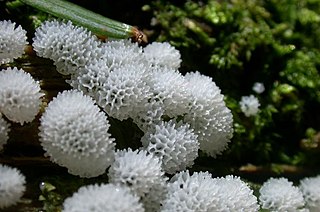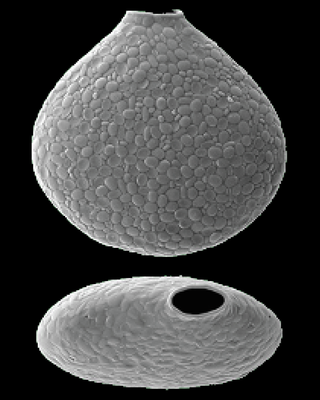
Amoebozoa is a major taxonomic group containing about 2,400 described species of amoeboid protists, often possessing blunt, fingerlike, lobose pseudopods and tubular mitochondrial cristae. In traditional classification schemes, Amoebozoa is usually ranked as a phylum within either the kingdom Protista or the kingdom Protozoa. In the classification favored by the International Society of Protistologists, it is retained as an unranked "supergroup" within Eukaryota. Molecular genetic analysis supports Amoebozoa as a monophyletic clade. Modern studies of eukaryotic phylogenetic trees identify it as the sister group to Opisthokonta, another major clade which contains both fungi and animals as well as several other clades comprising some 300 species of unicellular eukaryotes. Amoebozoa and Opisthokonta are sometimes grouped together in a high-level taxon, variously named Unikonta, Amorphea or Opimoda.

Labyrinthulomycetes (ICBN) or Labyrinthulea (ICZN) is a class of protists that produce a network of filaments or tubes, which serve as tracks for the cells to glide along and absorb nutrients for them. The two main groups are the labyrinthulids and thraustochytrids. They are mostly marine, commonly found as parasites on algae and seagrasses or as decomposers on dead plant material. They also include some parasites of marine invertebrates and mixotrophic species that live in a symbiotic relationship with zoochlorella.

Chaos is a genus of single-celled amoeboid organisms in the family Amoebidae. The largest and most-known species, the so-called "giant amoeba", can reach lengths up to 5 mm, although most specimens fall between 1 and 3 mm.

Difflugia is the largest genus of Arcellinida, one of several groups of Tubulinea within the eukaryote supergroup Amoebozoa. Arcellinida species produce shells or tests from mineral particles or biogenic elements and are thus commonly referred to as testate amoebae or shelled amoebae. Difflugia are particularly common in marshes and other freshwater habitats.

The Archamoebae are a group of protists originally thought to have evolved before the acquisition of mitochondria by eukaryotes. They include genera that are internal parasites or commensals of animals. A few species are human pathogens, causing diseases such as amoebic dysentery. The other genera of archamoebae live in freshwater habitats and are unusual among amoebae in possessing flagella. Most have a single nucleus and flagellum, but the giant amoeba Pelomyxa has many of each.

The raphidophytes, formally known as Raphidophycidae or Raphidophyceae, are a small group of eukaryotic algae that includes both marine and freshwater species. All raphidophytes are unicellular, with large cells, but no cell walls. Raphidophytes possess a pair of flagella, organised such that both originate from the same invagination. One flagellum points forwards, and is covered in hair-like mastigonemes, while the other points backwards across the cell surface, lying within a ventral groove. Raphidophytes contain numerous ellipsoid chloroplasts, which contain chlorophylls a, c1 and c2. They also make use of accessory pigments including β-carotene and diadinoxanthin. Unlike other heterokontophytes, raphidophytes do not possess the photoreceptive organelle typical of this group.

Phalansterium is a genus of single-celled flagellated organisms comprising several species, which form colonies. Phalansterium produces tetraspores.

Acanthamoebidae is a family of single-celled eukaryotes within the group Amoebozoa.

Thecamoebidae is an Amoebozoa family.

Leptomyxida is an order of Amoebozoa.

Protosteliomycetes/Protosteliales (ICBN) or Protostelea/Protostelia/Protosteliida (ICZN) is a grouping of slime molds from the phylum Mycetozoa. The name can vary depending upon the taxon used. Other names include Protostelea, Protostelia, and Protostelida. When not implying a specific level of classification, the term protostelid or protosteloid amoeba is sometimes used.
Comandonia is a genus of Amoebozoa.

Trichosphaerium is a genus of amoebozoan protists that present extraordinary morphological transformations, both in size and shape, during their life cycle. They can present a test that may or may not be covered in spicules. They are related to the family Microcoryciidae, which contains other amoebae with tests, within the clade Corycidia of the phylum Amoebozoa.
Arachnula is a genus of amoeboid eukaryotes first described by Leon Cienkowski in 1876.
Mycobacterium lepromatosis is an aerobic, acid-fast bacillus (AFB), and the second known causative agent of Hansen's disease (leprosy). It was discovered in 2008. Analysis of the 16S rRNA gene confirms that the species is distinct from Mycobacterium leprae.
Lentisphaerota is a phylum of bacteria closely related to Chlamydiota and Verrucomicrobiota.

The vampyrellids, colloquially known as vampire amoebae, are a group of free-living predatory amoebae classified as part of the lineage Endomyxa. They are distinguished from other groups of amoebae by their irregular cell shape with propensity to fuse and split like plasmodial organisms, and their life cycle with a digestive cyst stage that digests the gathered food. They appear worldwide in marine, brackish, freshwater and soil habitats. They are important predators of an enormous variety of microscopic organisms, from algae to fungi and animals. They are also known as aconchulinid amoebae.

Nebela is a diverse genus of testate amoebae of cosmopolitan distribution, belonging to the family Hyalospheniidae. They are "prey agglutinated" or "kleptosquamic" organisms, meaning they take the inorganic plates from their prey to construct their test.

Alabasta is a genus of arcellinid testate amoebae belonging to the family Hyalospheniidae. It contains species with an elongated test and a strongly curved "pseudostome" with a flare and a notch in narrow view. These species previously belonged to the genus Nebela, but were later found to be a distinct monophyletic group different from Nebela. It is the sister group to Planocarina.
Multicilia marina is a flagellated, multiciliated amoeboid protist found in brackish water. It can take on many different morphological characteristics, some dependent on its environment, such as different quantities and orientations of flagella. Leon Cienkowski is credited with the first discovery of a species of this organism.














